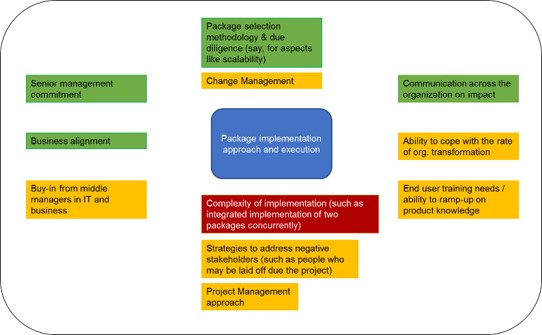Does Agile work for implementations of packages such as SAP, Oracle and others? This question has been asked many times in the light of some spectacular implementation failures – failures of such magnitude that organizations have gone bankrupt. The question is whether the water-fallish implementation approaches – often the prescribed methodology of the package provider – are to be blamed for such failures. Let’s look at this question from the standpoint of the package implementing organization.
Package solution providers would, of course, claim that their methodology has been tried, tested and tuned for success. They would also claim that their methodologies incorporate Agile approaches to achieve accelerated implementation. See SAP blog on the subject. No doubt the claim from SAP and similar claims from other providers are not without substance.
My submission is that apart from the implementation approach, there are a number of other contributing factors that are much more significant for the success or failure of package implementations – some typical recurrent factors (“industry patterns”) and some unique ones for your organization and project context. For example, “lack of business user alignment”, an industry pattern may be applicable in your case as well. Some other industry pattern – say, “senior management commitment” may not be as significant for you.
There could also be factors that are not an industry pattern but much very specific to your situation. For example, your implementation may entail concurrent implementation of two interfacing packages – one, say, for warehouse automation and the other for the rest of the enterprise.
The above can be represented in an influence map as shown below:
Package implementation influence map – example*

* Red box: Unique complexity factor to be addressed as a top priority; Yellow boxes: Several factors that are high on the list of priorities; Green boxes: Good to go / Strategies fully in place to address (at least for now!)
Agile approaches in implementation may be considered a part of the “Project Management approach” in the diagram above. This is already marked in yellow indicating that the capability within your own organization is not quite up to mark as is. You would want this to be addressed with the provider and/or a major consulting house taking full responsibility for it. Therefore, your organization needs to closely follow the provider’s/consulting house’s project management approach – Agile-enabled. If your business units and IT function have not had much experience in Agile software delivery and management, adapting to it would place a further strain on the organization’s capability to handle the implementation effectively. So, the following key questions need to be considered and answers sought from the overall project manager you have appointed:
- What are the aspects of the implementation amenable to be done in an Agile way? How does it work?
- What is the upfront foundational work that enables the Agile approach? What are the business decisions and product-related decisions to be made? See for example Agile for SAP solutions
- What are the other preparatory actions specific to enable the Agile approach in terms of training, resources etc.?
- Would user teams need a lot more hand-holding in the execution since the Agile approach may place demands in terms skill – say, in being able to express requirements as “stories” and refining them? Would the package provider address such needs and at what cost?
In conclusion,
- Agile does have a place in package implementations but that is just one factor among many others that may have a greater impact on success or failure; so, implementation approach by itself cannot be considered the failure factor
- Agile or how much Agile is something that the package provider should have typically figured out and incorporated it in his product context; they do work in select areas – for example, in incremental configuration of package components for user review – with the necessary ground work and preparation
- If I were to pick one factor in the above influence map that would greatly benefit from adopting Agile approaches, that would be the “Ability to cope with the rate of organization transformation”; in other words, Agile methods help set a pace that enables end users to adapt/adopt target transformations more effectively
If you have experiences to share in agile package implementations and comments on the above, would love to hear from you.
ShivK




